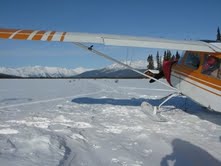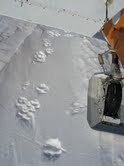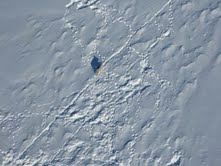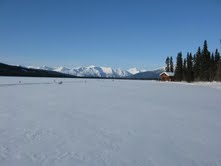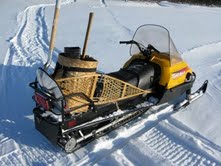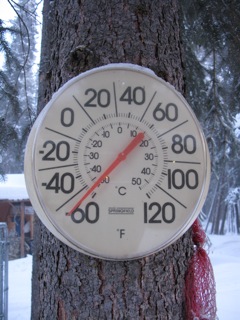2012 Alaska Reports
More Alaska Reports
March 2012 | January 2012 | June, 2011 | February, 2011 | January, 2011 | December, 2009 | October, 2009
|
|
Nutuvukti, Norutak, Minakokosa, and Avararaat are the names of just a few of the lakes that I have flown over lately. These are a mixture of Inupiat Eskimo and Athabascan Indian names. Some lakes - more out in the open of the wind blown tundra - are so drifted that one takes a chance on breaking a landing gear while landing at random, especially when the light is flat. One can tell the direction of the prevailing wind - especially during the last storm - by the shape of the drift; and, usually, there is a portion of the lake that is in the lee of the wind that has more of a flat surface for landing. Some of the lakes that are more protected by the trees have very little drifting, and - this year - the snow was particularly deep. Oftentimes, there is overflow under this deep soft layer. When landing in this sort of condition, one best have ample time to pack down a runway with snowshoes, and/or camp out for a few days until the overflow is frozen.
Since caribou are such a migratory species, it's difficult to know for sure in which area they are wintering. This year, a large herd is wintering in the Todatonten Lake area. As I flew over, there were a few hundred caribou on the ice. As a flock of ravens flew up, I started looking for wolves; since ravens are the scavengers that clean up the leftovers after a wolf kill. Sure enough, there were 3 wolves out on the ice; and I was fortunate enough to get a picture of one of the greys. The two most common colors of wolves in this area are grey and black; but occasionally one will find a white wolf.
For the past few weeks, "dog mushing" has been one of the hot topics in the Alaska news - the 1000 mile Yukon Quest from Fairbanks to Whitehorse, Yukon - the 1000 mile Iditarod from Anchorage to Nome - and this past weekend the North American sprint race in Fairbanks. Along with the actual dog racing competition, there are many other associated events involved. For example, last evening there was a Native "Potlatch" - or feast of native food - in Fairbanks. So far, the morning temperatures have been well below zero - with the day time highs rising up into the positive single digits - temperatures well liked by Alaskan Huskies.
Suicide is an issue that spells tragedy for so many friends and family of the victim. It is an all too common occurrence among remote villages in Alaska - often brought about by the abuse of alcohol and/or drugs. A Koyukon Athabascan gentleman from the village of Tanana, Mr. Vern Stickman, just finished a 150 mile walk down the Yukon River ice - stopping in various villages enroute - thereby bringing attention, discussion, and hopefully solutions - to this terrible subject.
During this time of year - late winter - a number of species of wildlife are having a hard time finding food. Caribou, for example, must paw through a deep layer of snow to find their primary food, the lichen. In doing so, they must expend a great deal of energy; and, in some cases, it's energy that the animal does not have after a long cold winter. Moose, too, have a tough time finding food while dragging their belly through the deep snow. Their chances of survival are better when they can find a packed trail - such as a dogsled or snowmobile trail. Moose on such trails - especially cows with calves - are extremely dangerous. Already this winter, there have been 3 cases of moose attacking humans. Soon, though, temperatures will warm to the point of melting; and food for both caribou and moose will be more readily available.
This morning, we saw the first light about 7 A.M.; and this evening - albeit a clear sky - darkness won't arrive until about 9 P.M. Lately, folks have been able to enjoy fabulous displays of the Aurora Borealis - or the Northern Lights. This phenomenon occurs in the Southern Hemisphere as well; and is there called the Southern Lights, or the Aurora Australis. Our friends in Antarctica may well be enjoying these tonight. Over 38 years in Alaska, I have on two occasions "heard" the swishing sound of the Aurora Borealis. In order to hear this spectacular event, there must be no wind; and it must be very cold. There was a point at which I was quite reluctant to admit the above; but, after speaking to others that have heard the Aurora, I'm now less fearful of being labeled a crack pot.
Another activity among "bush" dwellers occurring these days is the cutting and hauling of firewood. We use both spruce and birch. If the wood chunks can be split and put in the wood shed, they will cure and dry nicely over the summer. Dry wood will produce far less creosote in the stove when burned next winter. In former times - say as late as the 1930s or 1940s - paddle steamers traveled the Yukon and Tanana Rivers, delivering both freight and passengers. The steam boilers of these vessels were powered with wood - often cut with cross cut saws - back in the days when "men were men"! Nowadays, us wimps use chainsaws; and, in my case, a Stihl.
The Polar Pumpkin is now sitting patiently with its mechanics. Over this weekend, in theory, the NASA owned hyperspectral imaging camera is being sent to Fairbanks for the re-installation in the Polar Pumpkin this next week. Then, when all systems are checked "good to go" - and the weather is appropriate for doing so - the Pumpkin and I will again head North to the Pole.
I'd be honored if you'd ride along . . .
JANUARY 29, 2012
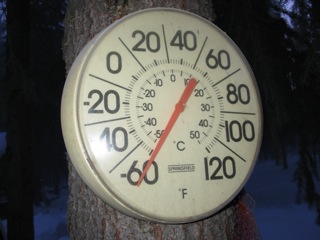 Sixty-two degrees below zero this morning. The central "business district" of this little village of 90 people was fairly quiet. "Not a creature was stirring, not even a mouse". Even on busy days, there's not a whole lot of traffic. "Gridlock" here are two dog teams on the same trail at the same time.
Sixty-two degrees below zero this morning. The central "business district" of this little village of 90 people was fairly quiet. "Not a creature was stirring, not even a mouse". Even on busy days, there's not a whole lot of traffic. "Gridlock" here are two dog teams on the same trail at the same time.
So what does one do when it's so cold? Most people stay inside close the stove - oil stoves or wood stoves. Since oil stoves occasionally have problems in the extreme cold, many people have wood stoves - fed with either spruce or birch logs. The ideal is to cut the wood a year in advance; and let it season (dry) in order to minimize creosote buildup in the chimney. All too many cabins have burned down due to uncontrollable chimney fires.
Even the dog mushers are staying home at this temperature. The Huskies are curled up inside their straw filled houses; and are likely looking forward to warmer temperatures, when they can be harnessed up and head down the trail. Most of the sled dogs have a good coat of under fur; so you may find some of them curled up in the insulating snow adjacent - outside - of their comfortable dog houses. The Yukon Quest dog sled race, from Fairbanks to Whitehorse, Yukon Territory, is coming up in a few days. Some of those mushers - in severe conditions - will provide small "jackets" and "booties" for their dogs.
Several days ago, the Anchorage news had a report of an 85 year old man that was attacked by a moose. It's flailing hooves hit him in the head; and knocked him deep in the snow. His wife was nearby; and, somehow, got a shovel to beat the moose off her husband. Both the woman's husband, and the moose, survived. Such an attack is not uncommon - especially this time of year - when the moose want to use the same packed trails as do people. The days are none too long yet here at this latitude; so it's important to pay close attention when walking in the bush - and especially at night.
Machinery doesn't do so well at these temperatures. Metal fatigues more easily, plastic cracks, and engines have difficulty maintaining enough heat to run properly. So, for the most part, folks just leave vehicles parked. Mail service here is provided 3 times per week - weather permitting - by a Cessna 206. Commercial small aircraft operators have canceled all services until temperatures moderate. I remember a few years back when I had to fly my Citabria at only 42 below zero. Normally my temperature cut off is 25 below. But, due to an emergency, I pushed the temps a bit; and when I went to put my snowshoes in the airplane, I bumped the interior headliner. It duly shattered on impact. Fortunately - some times - even though it's so cold on the ground, there's a temperature inversion; and one may find much warmer temperatures only a couple thousand feet aloft.
Even though one would expect the ice on rivers and lakes to be "growing" - i.e. thickening - at these temperatures, BEWARE. Snow - especially soft loose snow - is a particularly good insulator; and in these locations, ice may be growing less rapidly than expected. Also, river currents may undercut the ice - especially in shallower more "rapid" sections of the river. Occasionally there will be open holes bridged only with a layer of snow. There are stories of entire dog teams breaking through such snow layers - on rivers such as the Yukon - and disappearing forever. Years ago, I barely escaped such a situation, when my lead dog and the next two dogs broke through the ice. I managed to stop the rest of the team, before all of us went in; and stood by, while the first 3 dogs managed to scramble to the ice edge, shake, roll in the snow, and pull ice bits out of their paws with their teeth.
So . . . for the next day, or so, we'll sit here by the wood stove - reading, writing, and planning - the route to the North Pole in April.
The Polar Pumpkin is standing by for test flights, when the temperatures warm - perhaps later next week.
Your Inupiaq Eskimo words for the day: Alappaa, Arigaa, Taikuu
January 1, 2012 - New Year's Day
Manley Hot Springs, Alaska
|
A "nippy New Years Day, 2012, -55 degrees Fahrenheit. |
Wood heat is some of the most dependable and uniform to be had. |
The temperature dropped last night - down to -55 degrees Fahrenheit today.
So it's a good day to split wood. As with anything so cold, firewood blocks get brittle at this temperature; and split oh so good.
Hanging in front of the window, we have a bird feeder that we fill periodically. It's amazing that even today we had chickadees and red polls at the feeder.
As you might guess, the village of Manley Hot Springs has a hot springs. As the hot water exits the ground - and hits the cold air - it emits a cloud of steam. So down here in the trees - amid this cloud of steam - the atmosphere is ethereal, mystical, and the scene quite "wintry".
Although our propane doesn't flow at this temperature, we've got the trusty wood stove on which to cook.
Today is a reminder of how careful one must be during extreme temperatures in the Northern Winter. While cutting up a salmon roast last night, Damaris cut her thumb; and had some difficulty getting the bleeding stopped. For a serious emergency, however, one could not expect help in these temperatures. So, as best we can, we try to be self sufficient - with a good medical kit - and make all moves slowly and methodically.
Back to the wood pile.
Happy New Year!

